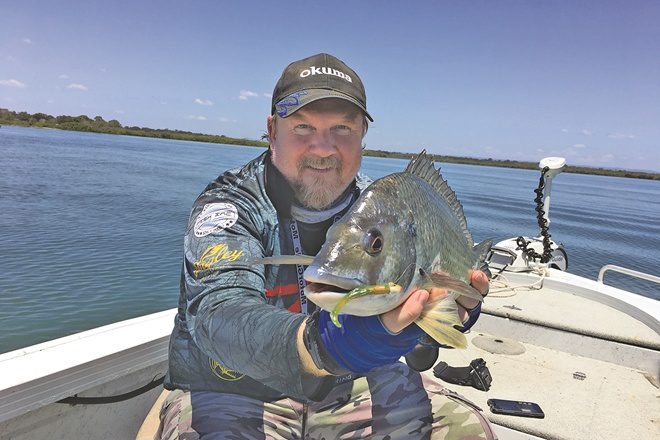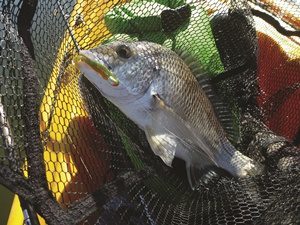
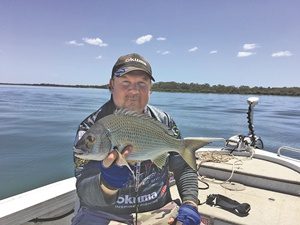
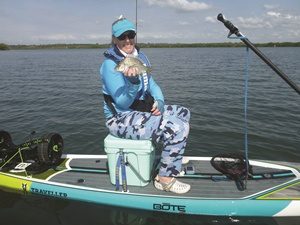
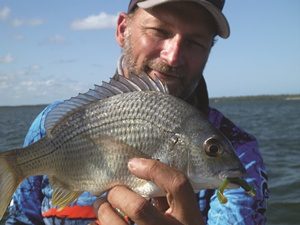
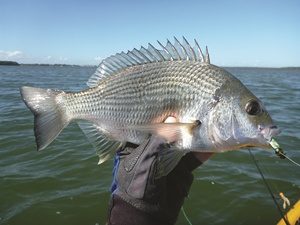
I AM happy to target any species that will eat my lures, and bream on light spin gear can be both fun and challenging. When a big bream eats your soft plastic and switches on the afterburners, it’s cool to watch the line cut through the water and feel your inner ninja switch on as you employ some crazy rod work to keep the fish away from line destroying structure.
Here’s a few natural structure types I like to target bream around and successful techniques for fishing each type of structure. Soft plastics bream
Weed flats
My favourite bream fishing generally revolves around weed flats covered by the high tide with a metre or more of water. I will generally target the last hour or two of the run-in tide and the first hour of the run-out, as I find that this is when the fish are actively trying to make the most of this high tide feeding ground.
If the conditions are windy, use the wind to move you across the flat and make long casts with the it. If there is little or no wind, use a tidal drift and fan casts around the boat. Always keep an eye out for bait flicking and if you see bait, try to make a cast to itSoft plastics bream
It’s always important to mix the retrieve up until you find out what the fish want. I generally kick things off with a long cast, followed by a couple of hops before the lure buries in the weed and then I slowly roll it above the weed. You can break up the retrieve with an occasional short pause or twitch of the rod. My go-to presentation is either a Z-Man 2.5” Slim SwimZ or GrubZ, rigged on a 1/4oz 1/0 TT Lures DemonZ jig head.
Mangrove edges
Bream love feeding around mangrove edges on high tide and you can often combine a weed flat and its surrounding mangrove edges into one session. I generally work the same tides as the weed flats, however on very large tides the bream can disappear back into the mangroves and out of casting reach, so on these tides it’s worth working the edges a little earlier on the run-in and even a little later on the run-out.Soft plastics bream
Some systems have acres of mangrove edges, so look for stand-out features such as points, breaks in the mangroves, laydown timber, drains and sections where the green mangrove leaves are in the water. It is also important to pay extra attention to areas that have active bait and where the wind is blowing onto the mangroves, stirring and oxygenating the water, offering cover for the fish and allowing long casts.
When fishing mangrove edges, the aim is to get the plastic in tight to structure, hop, twitch and roll it to avoid snagging on the mangrove root spikes.\ Once clear of the spikes, you can mix up the retrieve between the previously mentioned retrieve for the flats and a hopping and pausing retrieve on the bottom.Soft plastics bream
I will fish the aforementioned plastics on a lighter 1/12-1/8oz TT Lures HeadlockZ Finesse jighead, or alternatively throw my go-to Z-Man 2.5” TRD BugZ or TRD CrawZ on a 1/10oz TT Lures NedlockZ. This Ned Rig presentation is dynamite, representing a crab or other crustacean, and it can be hopped and shaken around the mangrove edges and then allowed to fall naturally to the bottom where the naturally buoyant claws will stand up in a natural defensive pose, attracting fish and triggering strikes.
Drop-offs
When my local waterways get busier with boats and jet skis, it often spooks the bream off the shallow flats and mangrove edges. If I can’t find the fish in these areas, I will seek out drop-offs and edges that fall to 2-3m deep. If these drop-offs have structure such as weed, rock and rubble, this makes them even better.Soft plastics bream
Combine this with water movement and breaks and eddies created by the structure, and you are onto a winner. This type of area is excellent for bream, while also potentially putting you onto snapper, trevally, tailor and a variety of other species. When approaching these areas try not to drive through where you want to fish.
Even though it is deeper the fish will still spook, and this is especially true for big bream or any snapper that may be holding in the area. Make casts up onto the shallow side of the drop-off and then work your soft plastic down the edge. If it isn’t too snaggy you may wish to stay in contact with the bottom, otherwise try and keep the lure as close to the structure as possible.Soft plastics bream
It is also important to fish the bottom edge of the drop-off, as there is often a basin and break from the current where fish will school. At times you may wish to fish as light as 1/16 or 1/12oz to make the most of a slow natural fall and give the fish plenty of time to see the lure coming, especially when there is less tidal flow.
I will generally fish my flats presentations fast, looking for actively feeding fish, rather than working hard to switch on fish that don’t want to play. At times though, the ‘go light to get the bite’ scenario may be your only option.Soft plastics bream
That’s a quick look at targeting bream around natural structure on soft plastics, and although a simplified look at what could be a monster volume written on bream, I am confident that these plastics and techniques will work throughout Australia, having been lucky enough to have caught bream in most states. Get out there, hit your local rivers and estuaries and get ready for some ninja rod work battling bream around structure.Soft plastics bream
See you on the water…
Click here for Justin’s guide to fishing with weedless soft plastics!
 Bush ‘n Beach Fishing Magazine Location reports & tips for fishing, boating, camping, kayaking, 4WDing in Queensland and Northern NSW
Bush ‘n Beach Fishing Magazine Location reports & tips for fishing, boating, camping, kayaking, 4WDing in Queensland and Northern NSW

